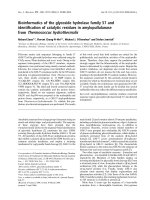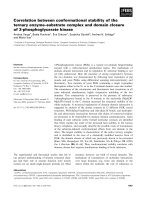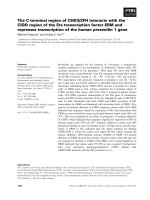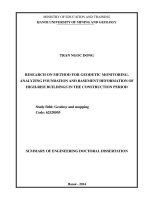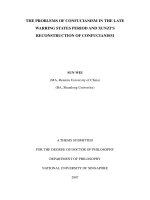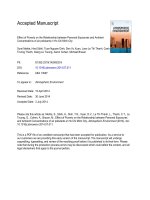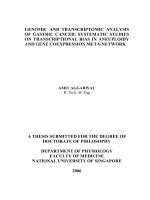On understanding the sequential post-synthetic microwave-assisted dealumination and alkaline treatment of Y zeolite
Bạn đang xem bản rút gọn của tài liệu. Xem và tải ngay bản đầy đủ của tài liệu tại đây (5.53 MB, 9 trang )
Microporous and Mesoporous Materials 333 (2022) 111736
Contents lists available at ScienceDirect
Microporous and Mesoporous Materials
journal homepage: www.elsevier.com/locate/micromeso
On understanding the sequential post-synthetic microwave-assisted
dealumination and alkaline treatment of Y zeolite
Rongxin Zhang a, b, Run Zou b, Wei Li c, Yabin Chang c, Xiaolei Fan b, *
a
Research Institute of Petroleum Processing, SINOPEC, 18 Xueyuan Road, Beijing, 100083, China
Department of Chemical Engineering and Analytical Science, School of Engineering, The University of Manchester, Manchester, M13 9PL, UK
c
Department of Materials, School of Natural Sciences, University of Manchester, M13 9PL, UK
b
A R T I C L E I N F O
A B S T R A C T
Keywords:
Y zeolite
Post-synthetic treatment
Dealumination
Microwave (MW)
NMR
Systematic investigation was performed to understand the change of physiochemical properties in Y zeolite after
the microwave (MW)-assisted dealumination (using mineral acid, HCl, and chelating agent, EDTA4− ) and the
subsequent alkaline treatment (of the dealuminated zeolites). The findings show that the combination of EDTA4−
and hydrogen ions was effective to achieve dealumination of zeolite Y under MW irradiation, which formed
complexed framework Al, instead of extra-framework Al (EFAl), to be extracted readily by the sequential alkaline
treatment for mesopore formation. Conversely, under the same MW condition, the use of HCl encouraged the
formation of EFAl species in the defective Y framework, which did not benefit the mesopore formation. The
disclose of the distinct dealumination mechanisms of the MW-assisted method using different agents can benefit
the further development of effective MW methods for dealumination of zeolites and/or making mesoporous
zeolites.
1. Introduction
Zeolites, as crystalline aluminosilicates with the intrinsic micropo
rous frameworks, high specific surface areas and good thermal stability,
are widely used in heterogeneous catalysis such as petrochemical
refining processes [1]. Specifically, zeolite Y (with the FAU topology),
Beta (with the BEA topology) and ZSM-5 (with the MFI topology) have
significant industrial values [2–4]. During catalysis, the intrinsic
microporosity of zeolites (pore sizes <1 nm) leads to accessibility and
diffusion issues which deactivate the zeolite catalysts [5]. Accordingly,
efforts have been made develop relevant strategies of designing and/or
modifying zeolites to improve the accessibility of the active sites in the
framework, which exemplified by nano-sized, 2-dimensional and mes
oporous zeolites [6–8]. Among these strategies, post-synthetic treat
ments, such as calcination, steaming and acid/base leaching, are a class
of methods for making zeolites with mesoporosity [9–11], being rela
tively robust and practical, as well as suitable for possible scaling up
toward applications in practical settings [12,13].
Appropriate selection of the post-synthetic treatments depends on
the property of the parent zeolites. For the most important parent zeolite
for catalysis, i.e., zeolite Y with low atomic silicon-to-aluminium ratio
(SAR, ~2.6), post-synthetic dealumination by steaming or acid/
chemical leaching is the prerequisite for creating secondary mesopores
and improving hydrothermal stability of the resulting zeolites [9–11].
Therefore, mechanistic understanding of dealumination and mesopore
formation processes is necessary to enable the optimisation of the pro
cess, as well as the rational design of relevant mesoporous Y zeolites.
Both theoretical (such as density functional theory, DFT) and experi
mental (such as solid-state nuclear magnetic resonance, NMR, spec
troscopy [14–16]) studies of the dealumination mechanism were
performed for steaming and acid leaching treatments, and relevant re
sults showed the important role of water and hydrolysis of framework
Al–O bond for producing EFAl species (which could be removed from
the framework to render mesopores) [17–21].
Recently, a microwave (MW)-assisted chelation, i.e., MWAC, method
was developed to show the high efficiency in reducing the treatment
time and energy consumption, as well as being highly effective to create
hierarchical mesopores [22,23]. The MWAC method was developed
based on the post-synthetic chemical treatment using chelating agents
such as ethylenediaminetetraacetic acid (H4EDTA) [24]. In comparison
with the recent relevant methods under conventional hydrothermal
conditions [25,26], the MWAC method significantly reduced the treat
ment time from at least 6 h to minutes (for dealumination), and hence
reduced the energy consumption of the process. Although preliminary
* Corresponding author.
E-mail address: (X. Fan).
/>Received 6 December 2021; Received in revised form 28 January 2022; Accepted 29 January 2022
Available online 8 February 2022
1387-1811/© 2022 The Authors. Published by Elsevier Inc. This is an open access article under the CC BY license ( />
R. Zhang et al.
Microporous and Mesoporous Materials 333 (2022) 111736
results have suggested the direct chelation of framework Al during the
MWAC treatment, mechanistic understanding of chemical deal
umination under MW irradiation is not yet fully understood.
Herein, we present a comparative investigation of the mechanism of
dealumination and mesopore formation in zeolite Y via the sequential
MW-assisted dealumination and alkaline treatments, specifically in the
dealumination step, comparative experiments using the chelating agent
of H4EDTA, sodium form EDTA (i.e., Na4EDTA), mineral acid of HCl and
a mixture of Na4EDTA and HCl under the MW condition were carried
out. The physiochemical properties of the relevant zeolitic materials at
different stages of the treatments were comprehensively characterised
by N2 physisorption, XRD, ICP-OES, TEM and liquid-/solid-state NMR
analyses, which contributed to the interpretation of the dealumination
mechanism of the MWAC method. In addition, in situ IR studies of the
MWAC treated zeolites (using deuterium water, D2O, and water as
media without a chelating agent) was performed to gain the additional
information on the role of water molecule in the MWAC process.
analysis using the parent Y zeolite as the reference, and the total in
tensity of the eight strongest reflections in the region of 2θ from 15◦ to
36◦ , the method was described in previous literature [27]. N2 phys
isorption measurements were performed at − 196.15 ◦ C using Micro
meritics 3Flex Surface Characterisation Analyser. Before measurement,
the sample (~100 mg) was degassed at 350 ◦ C under vacuum for 12 h.
´th-Ka
Pore size distributions (PSD) were determined using the Horva
wazoe (HK) method for micropores and the Barrett-Joyner-Halenda
(BJH) method for mesopores. Elemental Si and Al concentrations in
liquid phase were measured by ICP-OES (Quant PQ 900). Bulk SAR of
zeolites was determined by an EDXRF spectroscopy (PANalytical Mini
Pal 4 EDXRF, operated at 30 kV). Microscopic morphology of materials
was investigated using high-resolution TEM (HRTEM), which was per
formed on an FEI Tecnai G20 transmission electron microscope oper
ating at 200 kV. Before TEM analysis, the samples were dispersed in
acetone by sonication for 1 h and dropped on carbon-coated copper
grids.
Solid-state 29Si and 27Al MAS NMR analysis was performed on a
Bruker Bruker Avance III 400 instrument (MHz) using 4 mm ZrO2 rotors
at 21 ◦ C. 29Si MAS NMR spectra were acquired at 80 MHz with 4096
number of scans, pulse width (PW) = 2.5 μs, recycle delay (D1) = 10 s,
acquisition time (AQ) = 0.05 s, free induction decay (FID) = 3964
points, scanning = 4096 times, dwell time (DW) = 12.6 μs, and receiver
gain = 1150. 27Al MAS NMR spectra were obtained at 104 MHz with
1024 number of scans, PW = 2.5 μs, D1 = 5 s, and DW = 6 μs? The data
AQ and FID were set to 0.024 s and 3964 points, respectively. All MAS
NMR spectra were recorded at a spinning rate of 11 kHz. Chemical shifts
were referenced to 1 M Al(NO3)3 for Al and tetramethylsilane (TMS) for
Si with a secondary reference sample of Al-ZSM-5. All liquid NMR
spectra were recorded on a Bruker AVIII HD 400 with PW = 11.75 μs,
pulse angle = 15◦ , D1 = 1 s, AQ = 0.1966 s at 104.261 MHz. The number
of scans was 32 with a DW = 12 μs and FID = 1,6384 points. 5 cm long
capillary with deuterium water (D2O) was applied to avoid the
contamination for the field-frequency locking [28]. 1 M Al(NO3)3 and
TMS were used as the external chemical-shift reference for 29Si and 27Al,
respectively.
2. Experimental
2.1. Materials and methods
The parent Y zeolite was purchased from Zeolyst International (CBV
300 with molar SAR = 2.6). Hydrochloric acid (HCl, reagent, 37%,
Aldrich), ethylenediaminetriacetic acid (H4EDTA, bioultra, ≥99%,
Aldrich), ethylenediaminetriacetic acid tetrasodium salt dihydrate
(Na4EDTA⋅2H2O, bioreagent, 99.0–102.0%, Aldrich) and sodium hy
droxide (NaOH, reagent grade, 97%, Aldrich) were all used as received.
The liquid media for the MWAC treatment include 0.1 M H4EDTA,
0.4 M HCl, 0.1 M Na4EDTA and 0.1 M Na4EDTA/0.4 M HCl. Specifically,
0.1 M H4EDTA solution was prepared by dissolving 584.5 mg H4EDTA
in 20 ml deionized water; 0.4 M HCl solution was prepared by dissolving
789.2 mg HCl solution (37%) in 19.5 ml deionized water; 0.1 M
Na4EDTA solution was prepared by dissolving 760.3 mg Na4EDTA in 20
ml deionized water; 0.1 M Na4EDTA/0.4 M HCl solution was prepared
by dissolving 760.3 mg Na4EDTA and 789.2 mg HCl solution (37%) in
19.5 ml deionized water. In a typical MWAC treatment, 2 g parent
zeolite was dispersed into a 20 mL solution in a 35 ml Pyrex pressure
vessel and stirred for 5 min at room temperature. The mixture was
subsequently transferred in a CEM Discover SP microwave reactor to
conduct the post-synthetic dealumination treatments under the MW
condition (temperature programme, room temperature to 100 ◦ C in 2
min followed by isothermal treatment for 1 min at 100 ◦ C). Details of the
MW method was also described elsewhere [22,23]. After the treatment,
the resulting slurry was quenched to 30 ◦ C in ice bath, and then the solid
was separated by centrifugation. The remaining liquid phase from the
separation was kept for further ICP-OES and NMR analysis. The solid
was washed with deionized water (DI) till the pH value reached ~7 and
dried in an oven at 100 ◦ C overnight. The resulting modified Y zeolites
were denoted as MWa, where a referred to the chemicals in the solution,
i.e., EA for H4EDTA, HCl for hydrochloric acid, EN for Na4EDTA and
ENH for the mixture of Na4EDTA and HCl).
After the MW treatment, sequential alkaline treatment was per
formed on the modified Y zeolites at 65 ◦ C using 0.2 M NaOH aqueous
solution for 30 min (1 g zeolite per 30 mL NaOH solution), followed by
washing with DI water. Then, the sample was separated by centrifuga
tion and dried at 100 ◦ C. The resulting materials were named as MWa +
HT.
2.3. IR study with isotopic labelling
To understand the role of water in the MWAC treatment, isotopic
labelling using D2O (to substitute DI as solvent) in the MWAC modifi
cation of Y zeolite using EA was performed, and the sample was denoted
as MWEA-D. The resulting samples were investigated in situ by IR
microspectroscopy based in the B22 beamline (i.e. Multimode InfraRed
Imaging and Microspectroscopy, MIRIAM, beamline) at the Diamond
Light Source, Harwell Science Campus (UK). The IR system is comprised
of a Bruker Hyperion 3000 microscope with a 15 × objective and liquid
nitrogen cooled Mercury–Cadmium-Telluride (MCT) detector, coupled
to a Bruker Vertex 80 V Fourier Transform IR interferometer using ra
diation generated from a bending magnet source. During the measure
ment in transmission, spectra were collected (512 scans) in a range
500–4000 cm− 1 with 4 cm− 1 resolution, and infrared spot size on the
sample was approximately 20 × 20 μm. Samples were diluted with po
tassium bromide (KBr) placed onto a zinc selenide (ZnSe) disk then
placed in a Linkam FTIR 600 gas-tight sample cell equipped with ZnSe
windows, a heating stage and gas inlet and outlets. During the in situ IR
characterisation at atmospheric pressure, dry N2 (using a zeolite filtre)
were dosed volumetrically to the sample cell via mass flow controllers
(at 100 cm3 min− 1). The specific sampling position of a sample was
visually selected using the microscope, then infrared spectra were
measured under the conditions of drying under N2 at room temperature
(RT, ~25 ◦ C) for 1 h, and heating from RT to 300 ◦ C. In situ diffuse
reflectance FT-IR spectroscopy (DRIFTS) was performed with a Bruker
Vertex 70 FTIR spectrometer equipped with a liquid N2-cooled detector.
In situ DRIFTS spectra were recorded at 256 times every spectrum with a
resolution of 4 cm− 1 and analysed with the OPUS software. The samples
2.2. Characterisation of materials
Powder XRD patterns of materials were obtained on Philips X’Pert Xray diffractometer with monochromatised CuKα1 radiation (40 kV, 30
mA, λ = 1.5406 Å). Powder XRD data were recorded in a 2θ range of
8◦ –40◦ with an angular step size of 0.0199◦ . Relative crystallinity (RC)
of materials under investigation was determined based on powder XRD
2
R. Zhang et al.
Microporous and Mesoporous Materials 333 (2022) 111736
Fig. 1. (a) FT-IR spectra of MWEA and MWEA-D Y zeolites at RT and 300 ◦ C, H-form parent Y zeolite at RT and liquid D2O; (b) IR spectra in the region from 1800 to
600 cm− 1 of (a); and (c) DRIFTS spectra of MWEA and MWEA-D in the OH stretching region at 110 ◦ C.
located on the external surface of the zeolites; around 3730 cm− 1 and
3692 cm− 1 assigned to Si–OH inside zeolite structure; ~3658 cm− 1
related to Al–OH groups; and ~3638 cm− 1 due to the bridged Si–OH–Al
in supercages and hexagonal prisms (i.e., Brønsted acid sites) of FAU
type zeolites. Interestingly, the IR spectrum of MWEA-D did not the
characteristic bands of OD group, which normally locates at ~2500 and
~1200 cm− 1.
Cruz et al. [20] studied the post-treatment of clinoptilolite (HEU
type, byaqueous HCl solution at RT) using hybrid density functional
theory (DFT), and proposed the dealumination mechanism via the
following steps, that is, (i) breakage of Al–O bonds by proton attack, (ii)
adsorptive coordination of two water molecules with Al, (iii) formation
of 5-coordinated Al with a double Si–OH–Al bridges and with three
water molecules, and (iv) formation of octahedral Al atoms (EFAl) due
to the rearrangement between Al and the neighbouring O atoms. The
findings of the DFT study suggested the important role of water mole
cules in dealuminating framework Al under the conventional hydro
thermal via acid leaching, which contributes to the formation of EFAl.
However, the findings of the comparative IR study of the MWEA and
MWEA-D samples showed the insignificant contribution of water mol
ecules to the dealumination of Y zeolite under the MWAC condition, that
is, IR bands related to OD group was not measured for the MWEA-D
sample from the MWAC treatment with isotopic labelling (using
deuterium water as the solvent).
Under the MW condition, (EDTA)4− was hypothesised to be impor
tant for Al extraction, i.e., via coordination with EFAl and stabilisation
of the zeolite framework. As shown in Fig. 2a, liquid state 27Al NMR of
the MWEA filtrate showed only one broad peak at ~39 ppm, repre
senting a complex of Al3+ with (EDTA)4− , that is, [Al(EDTA)]− ,
were first heated under argon (Ar, 99.999%, BOC gas Ltd., total flow
rate = 50 ml min− 1) from RT to 110 ◦ C at a ramp rate of 10 ◦ C min− 1,
and then held at 110 ◦ C for 1 h. After that, the samples were cool down
under Ar to RT.
3. Results and discussion
3.1. MW-assisted chelation
In situ IR study of isotopic labelled Y zeolite samples from the MWAC
treatment was performed to understand the participation of water
molecules in dealumination of zeolite Y via MWAC. In both MWEA and
MWEA-D samples, IR bands related to hydroxyl groups at 1635 cm− 1
and 3700–3000 cm− 1 (corresponding to the adsorbed water molecules
and surface hydroxyl groups in Y zeolites) were identified. With an in
crease of temperature (from RT to 300 ◦ C), the intensity of the IR bands
diminished, as shown in Fig. 1a and b. Bands at 785 and 1006 cm− 1
corresponds to internal tetrahedral symmetrical stretching and asym
metrical stretching vibrations, respectively. As compared to that of the
parent Y, both shifted to higher wavenumber due to the reduced Al
species in MWEA and MWEA-D (since Si presents relatively higher vi
bration frequency than Al) [29]. The band at 903 cm− 1 corresponding to
Si–OH vibration was measured in MWEA and MWEA-D at RT, suggesting
the formation of silanol nests after MWAC dealumination of the parent
Y. The Si–OH band disappeared gradually as the temperature increased
to 300 ◦ C, indicating the re-insertion of the Si species into the framework
vacancies (cause by dealumination) to stabilise the structure [30].
Fig. 1c shows the DRIFTS spectra of OH groups in MWEA and MWEA-D
with several OH stretching bands, i.e., ~3740 cm− 1 due to Si–OH
Fig. 2. (a) liquid state 27Al NMR of filtrates separated after the MW-assisted dealumination treatment of Y zeolite using different agents; 27Al MAS SS-NMR spectra of
(b) after MW-assisted dealumination modified Y zeolites before calcination and (c) after calcination.
3
R. Zhang et al.
Microporous and Mesoporous Materials 333 (2022) 111736
Table 1
Yields of zeolite samples from the MW-assisted dealumination treatment, Si and
Al information on the resulting samples and the relevant filtrates from the
treatment.
Samples
Yield (%)
SARa (− )
Si/FAlb (− )
P
MWEA
MWEN
MWHCl
MWENH
–
88
99
90
86
2.68
4.25
3.18
3.56
3.43
2.50
4.40
2.75
5.48
3.63
a
b
c
Concentration of filtrate (g
L− 1)c
Al
Si
–
4.14
0.06
1.80
3.82
–
0.52
0.06
0.23
0.47
By XRF.
Based on29Si MAS NMR.
By ICP-OES.
according to the previous research [31]. Conversely, chemical shifts
associated with the diprotonated complex of H2[Al(EDTA)]+ and
hexa-aqua Al complex of [Al(H2O)6]3+ (at about 26 and 0 ppm,
respectively [31]) were not detected. In the filtrate of MWHCl, 27Al NMR
spectra presented monosignal at ~0.0 ppm, which corresponds to the
monomeric aquo-cation [Al(H2O)6]3+, suggesting that, for the system
with HCl under MW irradiation, formation of hydrolysed aluminium
complexes dominates [32]. The findings obtained so far show that the
dealumination mechanism of the MWAC method is fundamentally
different from that of the acid leaching (in aqueous media with a mineral
acid) and/or calcination methods [20]. Specifically, in combination
with the findings of IR studies above, one can propose that (EDTA)4− ,
rather than water molecules and/or the OH group of water, complexed
framework Al directly for effective Al extraction under the MWAC
condition.
After the MW-assisted dealumination treatment, SAR values of the
resulting samples increased as shown in Table 1, in comparison with the
SAR of the parent Y of 2.68 (by XRF). By analysing the filtrates from
different treatments, it was found that the MW-assisted dealumination
treatment with H4EDTA and (Na4EDTA + HCl) was very effective for
extracting Al from the FAU framework (into the bulk liquid), that is, the
Al concentration of the filtrate from the process of obtaining MWEA and
MWENH (i.e., 4.14 and 3.82 g L− 1, respectively) was much higher than
that from the process of 1obtaining MWHCl (3.80 g L− 1). Comparatively,
the MW treatment with Na4EDTA was not effective, as evidenced by the
lowest Al concentration in the filtrate of MWEN at 0.06 g L− 1. Also, by
comparing the ratios of Si to framework Al (Si/FAl, based on the Loe
wenstein rule [33]) of the parent Y (P, 2.50) and MWEN (2.75)
(EDTA)4− alone (i.e., without the excessive hydrogen ions), was not
capable of complexing FAl under MW irradiation for dealumination
(Na4EDTA aqueous solution was measured with a pH value of about 11).
As shown in Table 1, SAR and Si/FAl values of MWHCl are 3.56 and
5.48, respectively, showing that, under the MW condition, HCl could
destroy FAl, however, it was not effective for Al extraction. The latter
was confirmed by measuring the Al concentration of the filtrate from the
MW method of producing MWHCl, which is relatively low at 1.80 g L− 1.
Accordingly, the findings above suggest that, in the MW-assisted deal
umination treatment, both the chelating agent and the presence of
excessive hydrogen ions (i.e., acidic environment) are crucial for the
effective extraction of framework Al species, i.e., dealumination by the
MWAC method.
After dealumination, as shown in Fig. 2b and c, 27Al MAS NMR
spectra of the MW-assisted dealumination samples show the tetrahedral
Al (AlIV) signal centred at around 60 ppm. Additionally, the octahedral
Al (AlVI) signal (at ~0 ppm) was measured as well for MWHCl, con
firming the creation of EFAl in the defective framework of MWHCl from
the MW treatment with HCl solution, being in line with the findings
discussed above. By carefully examining the 27Al MAS NMR signals at
~60 ppm of MWEA, MWHCl and MWENH, they are rather asymmetric
as compared with that of the parent Y, as well as being broadened,
Fig. 3. 29Si MAS NMR spectra of the parent (P) and modified Y zeolites under
investigation.
Table 2
Information on Si(nAl) structure units of the zeolite samples determined by29Si
MAS NMR.
Sample
Si(4Al)
at − 85
ppm
Si(3Al)
at − 90
ppm
Si(2Al)
at − 95
ppm
Si(1Al)
at
− 101
ppm
Samples
P
MWEA
MWEN
MWHCl
MWENH
Integrated Area Percentage [%]
1.6
13.2
37.7
38.5
–
1.1
21.5
48.0
–
10.3
34.7
44.9
–
–
19.8
33.4
–
7.3
24.1
47.7
Si(0Al)
at
− 106
ppm
Amorphous
phases at
− 111 ppm
8.9
21.5
10.1
29.8
14.1
–
7.9
–
17.0
7.1
suggesting the presence of distorted AlIV species in their frameworks.
Previous work on the modified FAU Y zeolites (which was produced by
steaming [34,35] and calcination [18,36]) and USY zeolites [37–42]
(which have EFAl species in their structures) attributed the resonance
broadening to the presence of tetrahedral EFAl species (such as
aluminium-oxide) in the zeolitic frameworks. In this work, as shown in
Table 1, values of Si/FAl and SAR of the three samples are rather com
parable, indicating the possible absence of EFAl species in their frame
works. Accordingly, the asymmetrical resonance of AlIV in MWEA,
MWHCl and MWENH was attributed to the distorted Al species, being in
line with the previous findings [43–45]. However, 2-dimensional
double/multi-quantum MAS NMR study is necessary to investigate this
aspect further since one-dimensional single pulse 27Al MAS NMR is
unable to provide unambiguous Al coordination states.
Results of 29Si MAS NMR analysis of the samples are presented in
4
R. Zhang et al.
Microporous and Mesoporous Materials 333 (2022) 111736
Fig. 4. XRD patterns of (a) MWa samples and parent Y zeolite and (b) MWa + HT samples from the alkaline treatment of MWa samples and parent Y zeolite.
Regarding the crystallinity of the materials from the MW-assisted
post treatments, significant loss of relative crystallinity (RC) in MWEA
and MWHCl was measured by XRD, as shown in Fig. 4 and Table 3.
Additionally, amorphisation of MWEA and MWHCl was also obvious by
XRD (Fig. 4a) after the treatment, confirming the damage of the crys
talline framework of Y by H4EDTA and HCl under MW irradiation.
Comparatively, RC of MWEN was preserved rather well at 87%, proving
that Na4EDTA was not very effective for dealumination of Y under the
MW condition. By combining hydrogen ions with Na4EDTA in the sys
tem (i.e., Na4EDTA + HCl), dealumination process was improved to give
MWENH with a RC value of ca. 69%. Findings by XRD analysis suggest
various capacities of Al extraction of the MW system with different
agents, being in line with the relevant results (of SAR, Si/FAl and Al
concentration of the filtrate) by NMR analysis (Table 1). Regarding
mesoporosity formation, previous studies have shown that H4EDTA was
more capable than mineral acids under the hydrothermal conditions due
to its ability to remove FAl selectively [23,25,46]. Consequently, for
mation of mesoporosity in the framework can be attributed to the for
mation among silanol nests and associated vacancies in the zeolitic
framework [20,47–49]. N2 physisorption isotherms of the materials
under investigation are shown in Fig. S1a, and their porous properties
are presented in Table 3. In comparison with the parent Y (P), the
resulting MWEA and MWENH present the type-I isotherm but with the
relatively low N2 quantity adsorbed at low relative pressure (p/p0 <
0.01, i.e., the monolayer adsorption range), decreased specific surface
areas (i.e., BET surface areas, SBET, and micropore surface areas, Smicro)
and reduced micropore volumes (Vmicro). Comparatively, the use of HCl
under the MW condition damaged the microporous framework signifi
cantly, which is confirmed by the considerable reduction in SBET and
Smicro to 287 and 164 m2 g− 1, respectively. Again, the sole use of
Na4EDTA in the MW-assited post treatment was not effective for
creating mesopores in Y zeolite, as evidenced by the results of N2
physisorption analysis of MWEN, which are comparable to that of P.
Although previous research claimed that FAl elimination via mineral
acid dealumination can enlarge the defects in the zeolite structure,
relevant findings by N2 physisorption in Figs. S1a–S1c show conflicting
results. Therefore, it can be proposed that in MW-assisted dealumination
treatment, HCl contributes hydrogen ions to hydrolyse FAl to form EFAl
remained in the structure. Mesopore size distribution (PSD) of the
samples is shown in Fig. S1c. All post-treated samples showed the
development of mesopores, but being not significant. This was also
confirmed by TEM analysis of the samples, as shown in Fig. S2.
Discussion above suggests the importance of co-existence of
hydrogen ions and the chelating agent (i.e., (EDTA)4− ) to enable effec
tive dealumination of Y zeolite under MW irradiation. The findings so far
also suggest that the MWAC dealumination proceeded with distinct
features: (i) the remained hydroxyl groups in MWEA and MWAE-D were
not the result of water induced hydrolysis [24] but from H4EDTA-zeolite
Table 3
Porous properties and RC values of the parent (P), MWa (after the MW-assisted
treatment) and MWa + HT (MWa after the sequential alkaline treatment) Y
zeolites.
Samples
SBET
[m2
g− 1]
Smicro
[m2
g− 1]
Sexternal
[m2 g− 1]
Vtotal
[cm3
g− 1]
Vmicro
[cm3
g− 1]
Vmeso
[cm3
g− 1]
RC
[%]
P
MWEA
MWEN
MWHCl
MWENH
MWEA +
HT
MWEN +
HT
MWHCl
+ HT
MWENH
+ HT
867
484
831
287
472
747
858
383
738
164
403
675
9
101
69
113
93
72
0.36
0.25
0.39
0.19
0.20
0.41
0.35
0.16
0.30
0.07
0.16
0.31
0.01
0.09
0.09
0.12
0.04
0.10
100
20
87
4
69
88
936
822
114
0.43
0.32
0.11
99
340
303
37
0.19
0.16
0.03
42
807
649
158
0.45
0.27
0.18
96
Fig. 3 and Table 2. In the parent Y (P), all Si(nAl) structure units were
identified without amorphous phases. After the MW-assisted deal
umination treatment using H4EDTA, the Si(4Al) and Si(3Al) units were
reduced in the resulting MWEA (at 0 and 1.1%, respectively). The
decrease in the Si(4Al) and Si(3Al) structure units, as well as the increase
in the amorphous phase in Y zeolite confirm the removal of FAl due to
the MWAC treatment. Comparatively, after the MW treatment of Y using
Na4EDTA, the coordination environment in the resulting MWEN did not
change significantly compared to that of the parent Y (P), confirming the
relevant finding above based on the solid-/liquid-state NMR analysis, i.
e., the important role played by hydrogen ions to attack the Al–O–Si
bond in zeolite framework during the MW-assisted dealumination
treatment. Interestingly, during the post-treatment under MW irradia
tion, when HCl was used together with Na4EDTA (to provide hydrogen
ions), the obtained MWENH showed compositions of Si(nAl) structure
units similar to that of MWEA except higher percentage of Si(3Al) unit
(~7.3%), which again confirmed the finding above. Conversely, after
the MW-assisted treatment of Y using HCl solely, the coordination
environment of MWHCl was damaged more severely than that of
MWEA. According to the comparative 29Si MAS NMR analysis of P and
MWHCl, as shown in Table 2, (i) Si(3Al) units were eliminated entirely,
and Si(2Al) units decreased by ~50% and (ii) Si(0Al) units and amor
phous Si phases increased noticeably. The findings suggest that, under
the MW condition, HCl, as a mineral acid, has a strong ability to
hydrolyse Al–O–Si bonds in the zeolite framework. Additionally, based
on the comparative study of the Si(nAl) structure units of the parent Y
(P) and different zeolite samples from the MW-assisted treatments, the
Al-rich environment of P was beneficial to Al removal.
5
R. Zhang et al.
Microporous and Mesoporous Materials 333 (2022) 111736
dealuminated Y was able to heal the defective framework (likely via
EFAl realumination) and recover crystallinity partially, as reported
previously [50–53]. Based on 27Al MAS SS-NMR analysis of MWHCl
(Fig. 2b) and MWHCl + HT (Fig. 5a), and the quantitative analysis of Al
and Si species in the filtrate from the alkaline treatment of MWHCl, one
can propose the occurrence of EFAl realumination and Si removal during
the alkaline treatment of MWHCl.
29
Si MAS NMR spectra of MWa + HT samples are shown in Fig. 5.
MWEA + HT, MWEN + HT and MWENH + HT zeolites show analogous
Si(nAl) structure unit distributions to that of the parent Y zeolite. Spe
cifically, coordination change of Si atoms in MWEN + HT and total in
tensity variation of its Si(nAl) signals were insignificant as compared to
that of the parent Y, as shown in Table 5. In comparison with MWEA and
MWENH, the proportion of Si(nAl) sites, where n ≥ 2, was increased in
MWEA + HT and MWENH + HT after the alkaline treatment, especially
for the samples treated with H4EDTA. Specifically, proportions of Si
(4Al), Si(3Al) and Si(2Al) sites in MWEA are 0%, 1.1% and 21.5%,
respectively, whereas in MWEA-HT, they are 2.9%, 12.0% and 35.7%,
respectively. The findings suggest that the zeolite framework could be
recovered to a large extent by the alkaline treatment of the samples from
the MWAC treatment. For MWHCl + HT, as shown in Figs. 5b and Si
(4Al) and Si(3Al) signals could not be deconvoluted, suggesting the se
vere damage of the Al–O–Si bond by HCl under then MW condition,
Table 4
ICP-OES analysis of soluble Al and Si species in the filtrates from the sequential
alkaline treatment of dealuminated Y zeolites under investigation.
Samples
Al (g L− 1)
Si (g L− 1)
MWEA + HT
MWEN + HT
MWHCl + HT
MWENH + HT
0.18
0.10
0.03
0.14
4.25
0.42
2.38
4.57
interaction, (ii) the solution Al complex of [Al(EDTA)]− was the only Al
product in the filtrate from the processes of obtaining MWEA and
MWENH, and (iii) after MWAC, EFAl species are not detected in the
rustling framework, being different from the case with HCl.
3.2. Subsequent alkaline treatment
After the MW-assisted treatments, all resulting samples underwent
the same alkaline treatment. In this work, ICP-OES analysis (Table 4) of
the resulting filtrates from the sequential alkaline treatment showed
noticeable dissolution of Si species from the system containing MWEA,
MWHCl and MWENH. In detail, Al and Si species leaching from the
sequential alkaline treatment of MWEA and MWENH are comparable
(for example at 4.25 and 4.57 g L− 1 for Si, respectively) and that from
the treatment of MWHCl are relatively low at 0.03 g L− 1 for Al and 2.38
g L− 1 for Si, respectively. Regarding MWEN, Al and Si species in its
filtrate after the sequential alkaline treatment were comparatively
insignificant at 0.10 and 0.42 g L− 1, respectively. This finding again
confirmed that the MW-assisted treatment with (EDTA)4− only was not
effective to extract FAl from zeolite Y, and the resulting MWEN has a low
SAR at 3.18, being resistant to alkaline desilication. Al species in the
filtrate from the sequential alkaline treatment of MWEA, MWEN and
MWENH zeolites are more concentrated (at about 0.14 g L− 1) than that
in the filtrate from the treatment of MWHCl (~0.03 g L− 1), confirming
that the MWAC treatment produce soluble Al species, which can be
removed at different stages of the sequential treatment (Fig. 2a and
Tables 1 and 2).
After the alkaline treatment, 27Al MAS SS NMR analysis of MWa +
HT samples was performed, showing the monosignal at ~60 ppm of
tetrahedral Al chemical shift (Fig. 5). Alkaline treatment of
Fig. 5. (a)
27
Al MAS SS-NMR and (b)
Table 5
Information on Si(nAl) structure units of the sequential desilicated zeolite
samples determined by29Si MAS NMR.
Si(4Al)
− 85
ppm
Samples
P
MWEA +
HT
MWEN +
HT
MWHCl
+ HT
MWENH
+ HT
29
Si(3Al)
− 90
ppm
Si(2Al)
− 95
ppm
Si(1Al)
− 101
ppm
Si(0Al)
− 106
ppm
Amorphous
− 111 ppm
Integrated Area Percentage [%]
1.6
13.2
37.7
38.5
2.9
12.0
35.7
43.0
8.9
7.3
–
–
1.3
10.6
37.8
41.4
8.9
–
–
–
32.7
63.3
–
–
2.9
8.3
37.0
42.5
9.2
–
Si MAS SS-NMR spectra of MWa + HT samples from the alkaline treatment of MWa samples.
6
R. Zhang et al.
Microporous and Mesoporous Materials 333 (2022) 111736
Fig. 6. HRTEM micrographs of (a) and (c) MWEA + HT, (b) and (d) MWENH + HT, (e) MWHCl + HT and (f) MWEN + HT.
which could not be recovered by the alkaline treatment after wards.
Additionally, by comparing the data related to the Si(0Al) sites and
amorphous Si phase in all samples under study (as shown in Tables 2 and
5), the total disappearance of amorphous Si phase and the reduction in
the Si(0Al) site proportion show the selectively desilication of Si species
without the protection of FAl [54], which may benefit the preferential
mesopore formation at silanol nests.
Figs. 4b and S3 and Table 1 present the crystalline and porous
properties of the MWa + HT samples. Compared to the MWa samples,
the microporous crystalline phase in the MWa + HT samples was
recovered from the corresponding MWa samples after the alkaline
treatment. Taking MWEA as the example, after the alkaline treatment,
Smicro of MWEA + HT was recovered to 675 m2 g− 1 (for MWEA, Smicro =
383 m2 g− 1) and RC was ~88%, being much higher than that of MWEA
(about 20%). XRD patterns (Fig. 4b) and RC values of the MWa + HT
samples (Table 3) show that the crystallinity of all samples after the
alkaline treatment was recovered to different extents. In detail, MWEA
+ HT and MWENH + HT have RC values of about 88% and 96%,
respectively, whereas MWHCl + HT still has the lowest RC value of
~42% which was resulted from the severe framework damage during
the MW-assisted treatment using HCl. The findings so far suggest that,
regardless the non-framework Al species created during the MW-assisted
treatment, realumination of dealuminated Y zeolites occurred during
the sequential alkaline treatment [55,56], which could partially recover
the microporosity and crystallinity of the dealuminated samples, but the
method using the combination of chelating agent and hydrogen ions is
more advantageous than that using mineral acids regarding the two
aspects.
MWEN + HT remained as microporous, which again conforms the
ineffectiveness of using Na4EDTA for dealumination under the MW
condition, as well as the subsequent hydrothermal alkaline treatment of
MWEN, being consistent with the discussion above, i.e., Na4EDTA
cannot remove FAl from the Y zeolite framework without H+ ions and
desilication is not encouraged with low SAR zeolites. After the sequen
tial alkaline treatment, Sexternal and Vmeso for MWENH + HT and MWEA
+ HT (Table 3) confirm the presence of mesoporosity in the two
materials, whereas their lower amount of quantity adsorbed at low
relative pressure (Fig. S3a) and smaller Smicro values, as compared to
that of P, suggest the loss of microporosity after the sequential treat
ment. PSDs of the MWa + HT samples are exhibited in Figs. S3c and S3d,
showing that MWENH + HT and MWEA + HT have the distribution
centred at around 5 and 8 nm, respectively.
MWHCl + HT presented the H2 type hysteresis loop with SBET =
~340 m2 g− 1 and total pore volume (Vtotal) = ~0.19 m3 g− 1, respec
tively, suggesting a significantly damaged framework. Additionally, the
specific external surface area and mesopore volume of MWHCl + HT are
significantly low at 37 m2 g− 1 and 0.03 m3 g− 1, respectively, showing
that the sequential MW-assisted dealumination (using HCl) and alkaline
treatment was not as effective as that with the chelating agent in
creating mesoporosity in Y zeolite. Insignificant mesoporosity of
MWHCl + HT could be assigned to EFAl realumination inhibits the
removal of silanol groups which is related to mesoporous formation
[16].
Morphology of the MWa + HT zeolites was characterised by HRTEM
(Fig. 6). Surface defects and well-developed mesoporous features were
observed clearly for MWEA + HT and MWENH, as shown in Fig. 5a–d.
According to mesopore PSDs of MWa + HT zeolites (Fig. S3c), MWENH
+ HT and MWEA + HT have the PSD centred at ~5 nm and ~8 nm,
respectively, being consistent with the findings by HRTEM as indicated
in Fig. 5c and d. The micrograph of MWHCl + HT (Fig. 6e) shows the
structural defects in the framework instead of mesopores, and MWEN +
HT (Fig. 6f) presents the crystal morphology similar to that of the
microporous parent Y zeolite (Fig. S2e).
4. Conclusions
The microwave-assisted chelation (MWAC) method is a newly
developed method for making mesoporous zeolites efficiently and
effectively. This work presents the systematic investigation of the mi
crowave (MW)-assisted dealumination (under the MW condition at
100 ◦ C and 150 W for 1 min with different agents) and the subsequent
alkaline treatment of zeolite Y to gain insights into the mechanism of
7
Microporous and Mesoporous Materials 333 (2022) 111736
R. Zhang et al.
dealumination and mesopore formation. The findings led to the
conclusion of that under the MW condition dealumination depends on
the participation of both chelating agents (in this case, EDTA4− ) and
hydrogen ions (H+). Based on the liquid-/solid-state analyses, it was
found that the mechanism of dealumination (of zeolite Y) with EDTA4−
(in presence of H+) and HCl under the MW condition is distinct. In
detail, the process with H4EDTA (i.e. the MWAC method) showed a
strong ability in direct framework Al removal, which results in the
creation of framework defects (i.e., less than 2 nm) along with silanol
nests. Conversely, HCl under MW irradiation destroyed the framework
Al–O bond of Y zeolite significantly, leading to the formation of EFAl in
the defective zeolite framework and structure collapse. Moreover, D2O
isotopic labelling proved that, in the MWAC system, H+ contributed to
hydrolysis of framework Al–O bonds and silanol group formation rather
than water molecules, proving the essential role played by H+ in the
MWAC method.
Sequential alkaline desilication was essential after the dealumination
treatments to recover the zeolitic framework (to some extents) and
render mesopores of the treated zeolites. It was found that the removed
amount of Si of the dealuminated samples was in line with Al extraction
in the dealumination step in order to remain a stable crystal structure. In
general, this study shows that, under the MW condition, the use of
chelating agent in presence of hydrogen ions was highly effective to
achieve the dealumination of Y zeolite, and the subsequent alkaline
treatment helped to recover the crystalline framework and create mes
oporosity, being more advantageous than the system using the mineral
acid.
[4]
[5]
[6]
[7]
[8]
[9]
[10]
[11]
[12]
[13]
[14]
CRediT authorship contribution statement
[15]
Rongxin Zhang: Writing – original draft, Visualization, Methodol
ogy, Investigation, Formal analysis, Data curation. Run Zou: Data
curation, Formal analysis, Visualization, Writing – review & editing.
Wei Li: Writing – review & editing, Data curation. Yabin Chang: Data
curation, Formal analysis, Writing – review & editing. Xiaolei Fan:
Writing – review & editing, Supervision, Resources, Project adminis
tration, Methodology, Funding acquisition, Formal analysis,
Conceptualization.
[16]
[17]
[18]
[19]
Declaration of competing interest
[20]
The authors declare that they have no known competing financial
interests or personal relationships that could have appeared to influence
the work reported in this paper.
[21]
[22]
Acknowledgments
[23]
This project has received funding from the European Union’s Hori
zon 2020 research and innovation programme under grant agreement
No 872102.
[24]
[25]
Appendix A. Supplementary data
[26]
Supplementary data to this article can be found online at https://doi.
org/10.1016/j.micromeso.2022.111736.
[27]
References
[28]
[1] D. Li, Y. Chen, J. Hu, B. Deng, X. Cheng, Y. Zhang, Synthesis of hierarchical
chabazite zeolite via interzeolite transformation of coke-containing spent MFI,
Appl. Catal., B 270 (2020) 118881.
[2] C. Wang, L. Zhang, X. Huang, Y. Zhu, G. Li, Q. Gu, J. Chen, L. Ma, X. Li, Q. He,
J. Xu, Q. Sun, C. Song, M. Peng, J. Sun, D. Ma, Maximizing sinusoidal channels of
HZSM-5 for high shape-selectivity to p-xylene, Nat. Commun. 10 (2019) 4348.
[3] L. Lin, A.M. Sheveleva, I. da Silva, C.M.A. Parlett, Z. Tang, Y. Liu, M. Fan, X. Han, J.
H. Carter, F. Tuna, E.J.L. McInnes, Y. Cheng, L.L. Daemen, S. Rudi´c, A.J. RamirezCuesta, C.C. Tang, S. Yang, Quantitative production of butenes from biomass-
[29]
[30]
8
derived γ-valerolactone catalysed by hetero-atomic MFI zeolite, Nat. Mater. 19
(2020) 86–93.
Z. Guo, X. Li, S. Hu, G. Ye, X. Zhou, M.O.J.A.C. Coppens, Understanding the role of
internal diffusion barriers in Pt/Beta zeolite catalyzed isomerization of n-heptane,
Angew. Chem. Int. Ed. 132 (2019) 1564–1567.
N. Wang, Y. Zhi, Y. Wei, W. Zhang, Z. Liu, J. Huang, T. Sun, S. Xu, S. Lin, Y. He,
A. Zheng, Z. Liu, Molecular elucidating of an unusual growth mechanism for
polycyclic aromatic hydrocarbons in confined space, Nat. Commun. 11 (2020)
1079.
S. Tao, X. Li, X. Wang, Y. Wei, Y. Jia, J. Ju, Y. Cheng, H. Wang, S. Gong, X. Yao,
H. Gao, C. Zhang, Q. Zang, Z. Tian, Facile synthesis of hierarchical nanosized
single-crystal aluminophosphate molecular sieves from highly homogeneous and
concentrated precursors, Angew. Chem. Int. Ed. 59 (2020) 3455–3459.
T. Weissenberger, B. Reiprich, A.G.F. Machoke, K. Klühspies, J. Bauer, R. Dotzel, J.
L. Casci, W. Schwieger, Hierarchical MFI type zeolites with intracrystalline
macropores: the effect of the macropore size on the deactivation behaviour in the
MTO reaction, Catal. Sci. Technol. 9 (2019) 3259–3269.
ˇ
J. Cejka,
R. Millini, M. Opanasenko, D.P. Serrano, W.J. Roth, Advances and
challenges in zeolite synthesis and catalysis, Catal. Today 345 (2020) 2–13.
A.A. Asadi, S.M. Alavi, S.J. Royaee, M. Bazmi, Dependency of acidic and surficial
characteristics of steamed Y zeolite on potentially effective synthesis parameters:
screening, prioritizing and model development, Microporous Mesoporous Mater.
259 (2018) 142–154.
A. Pande, P. Niphadkar, K. Pandare, V. Bokade, Acid modified H-USY zeolite for
efficient catalytic transformation of fructose to 5-Hydroxymethyl furfural (biofuel
precursor) in methyl isobutyl ketone–water biphasic system, Energy Fuels 32
(2018) 3783–3791.
J.R. García, M. Falco, U. Sedran, Impact of the desilication treatment of Y zeolite
on the catalytic cracking of bulky hydrocarbon molecules, Top. Catal. 59 (2016)
268–277.
A. Sachse, J. García-Martínez, Surfactant-templating of zeolites: from design to
application, Chem. Mater. 29 (2017) 3827–3853.
J. Jin, C. Peng, J. Wang, H. Liu, X. Gao, H. Liu, C. Xu, Facile synthesis of
mesoporous zeolite Y with improved catalytic performance for heavy oil fluid
catalytic cracking, Ind. Eng. Chem. Res. 53 (2014) 3406–3411.
D. Verboekend, R. Caicedo-Realpe, A. Bonilla, M. Santiago, J. P´
erez-Ramírez,
Properties and functions of hierarchical ferrierite zeolites obtained by sequential
post-synthesis treatments, Chem. Mater. 22 (2010) 4679–4689.
M.R. Apelian, A.S. Fung, G.J. Kennedy, T.F. Degnan, Dealumination of zeolite β via
dicarboxylic acid treatment, J. Phys. Chem. 100 (1996) 16577–16583.
J.C. Groen, L.A. Peffer, J.A. Moulijn, J. P´
erez-Ramírez, Mechanism of hierarchical
porosity development in MFI zeolites by desilication: the role of aluminium as a
pore-directing agent, Chem. Eur J. 11 (2005) 4983–4994.
D.L. Bhering, A. Ramírez-Solís, C.J.A. Mota, A density functional theory based
approach to extraframework aluminum species in zeolites, J. Phys. Chem. B 107
(2003) 4342–4347.
Z. Yu, A. Zheng, Q. Wang, L. Chen, J. Xu, J.-P. Amoureux, F. Deng, Insights into the
Dealumination of zeolite HY revealed by sensitivity-enhanced 27Al DQ-MAS NMR
spectroscopy at high field, Angew. Chem. Int. Ed. 49 (2010) 8657–8661.
M.-C. Silaghi, C. Chizallet, J. Sauer, P. Raybaud, Dealumination mechanisms of
zeolites and extra-framework aluminum confinement, J. Catal. 339 (2016)
242–255.
K. Valdivi´es-Cruz, A. Lam, C.M. Zicovich-Wilson, Full mechanism of zeolite
dealumination in aqueous strong acid medium: ab initio periodic study on HClinoptilolite, J. Phys. Chem. C 121 (2017) 2652–2660.
J. Sun, H. Fang, P.I. Ravikovitch, D.S. Sholl, Understanding dealumination
mechanisms in protonic and cationic zeolites, J. Phys. Chem. C 124 (2020)
668–676.
S. Abdulridha, Y. Jiao, S. Xu, R. Zhang, A.A. Garforth, X. Fan, Mesoporous zeolitic
materials (MZMs) derived from zeolite Y using a microwave method for catalysis,
Front. Chem. 8 (2020) 482.
S. Abdulridha, R. Zhang, S. Xu, A. Tedstone, X. Ou, J. Gong, B. Mao, M. Frogley,
C. Bawn, Z. Zhou, X. Zhang, S. Chansai, S.M. Holmes, C. Hardacre, A.A. Garforth,
S. Yang, Y. Jiao, X. Fan, An efficient microwave-assisted chelation (MWAC) postsynthetic modification method to produce hierarchical Y zeolites, Microporous
Mesoporous Mater. 311 (2021) 110715.
G.T. Kerr, Chemistry of crystalline aluminosilicates. V. Preparation of aluminumdeficient faujasites, J. Phys. Chem. C 72 (1968) 2594–2596.
D. Verboekend, G. Vil´e, J. P´erez-Ramírez, Hierarchical Y and USY zeolites designed
by post-synthetic strategies, Adv. Funct. Mater. 22 (2012) 916–928.
D. Verboekend, T.C. Keller, S. Mitchell, J. P´
erez-Ramírez, Hierarchical FAU-and
LTA-type zeolites by post-synthetic design: a new generation of highly efficient
base catalysts, Adv. Funct. Mater. 23 (2013) 1923–1934.
ASTM D3906-19, Standard Test Method for Determination of Relative X-Ray
Diffraction Intensities of Faujasite-type Zeolite-Containing Materials, 2019.
H. Maki, G. Sakata, M. Mizuhata, Quantitative NMR of quadrupolar nucleus as a
novel analytical method: hydrolysis behaviour analysis of aluminum ion, Analyst
142 (2017) 1790–1799.
B.A. Holmberg, H. Wang, J.M. Norbeck, Y. Yan, Controlling size and yield of zeolite
Y nanocrystals using tetramethylammonium bromide, Microporous Mesoporous
Mater. 59 (2003) 13–28.
M.B. Yue, T. Xue, W.Q. Jiao, Y.M. Wang, M.-Y. He, Dealumination, silicon insertion
and H-proton exchange of NaY in one step with acid ethanol solution, Microporous
Mesoporous Mater. 159 (2012) 50–56.
R. Zhang et al.
Microporous and Mesoporous Materials 333 (2022) 111736
[44] J.A. van Bokhoven, A. Roest, D. Koningsberger, J. Miller, G. Nachtegaal,
A. Kentgens, Changes in structural and electronic properties of the zeolite
framework induced by extraframework Al and La in H-USY and La (x) NaY: a 29Si
and 27Al MAS NMR and 27Al MQ MAS NMR study, J. Phys. Chem. B 104 (2000)
6743–6754.
[45] A. Al-Ani, R.J. Darton, S. Sneddon, V. Zholobenko, Nanostructured Zeolites: the
introduction of intracrystalline mesoporosity in basic faujasite-type catalysts, ACS
Appl. Nano Mater. 1 (2018) 310–318.
[46] H.K. Beyer, Dealumination techniques for zeolites, in: Post-synthesis Modification
I. Molecular Sieves (Science and Technology), Springer, Berlin, 2002, pp. 203–255.
[47] G.T. Kerr, A.W. Chester, D.H. Olson, Dealumination of zeolite Y by H4EDTA, Catal.
Lett. 25 (1994) 401–402.
[48] S. Malola, S. Svelle, F.L. Bleken, O. Swang, Detailed reaction paths for zeolite
dealumination and desilication from density functional calculations, Angew.
Chem. Int. Ed. 51 (2012) 652–655.
[49] R. Barrer, M. Makki, Molecular sieve sorbents from clinoptilolite, Can. J. Chem. 42
(1964) 1481–1487.
[50] J. Datka, B. Sulikowski, B. Gil, IR spectroscopic studies of dealuminated and
realuminated zeolite HY, J. Phys. Chem. 100 (1996) 11242–11245.
[51] B. Sulikowski, J. Datka, B. Gil, J. Ptaszynski, J. Klinowski, Acidity and catalytic
properties of realuminated zeolite Y, J. Phys. Chem. B 101 (1997) 6929–6932.
[52] D. Verboekend, G. Vil´e, J. P´erez-Ramírez, Mesopore formation in USY and Beta
zeolites by base leaching: selection criteria and optimization of pore-directing
agents, Cryst. Growth Des. 12 (2012) 3123–3132.
[53] C. Pagis, A.R.M. Prates, N. Bats, A. Tuel, D. Farrusseng, High-silica hollow Y zeolite
by selective desilication of dealuminated NaY crystals in the presence of protective
Al species, CrystEngComm 20 (2018) 1564–1572.
[54] M.S. Holm, S. Svelle, F. Joensen, P. Beato, C.H. Christensen, S. Bordiga, M. Bjørgen,
Assessing the acid properties of desilicated ZSM-5 by FTIR using CO and 2,4,6trimethylpyridine (collidine) as molecular probes, Appl. Catal., A 356 (2009)
23–30.
[55] D. Liu, S. Bao, Q. Xu, Structural evolution of dealuminated Y zeolites during KOH
solution treatment, Zeolites 18 (1997) 162–170.
[56] Z. Zhang, X. Liu, Y. Xu, R. Xu, Realumination of dealuminated zeolites Y, Zeolites
11 (1991) 232–238.
[31] R.K. Iyer, S.B. Karweer, V.K. Jain, Complexes of aluminium with
aminopolycarboxylic acids: 27Al NMR and potentiometric studies, Magn. Reson.
Chem. 27 (1989) 328–334.
[32] C.C. Perry, K.L. Shafran, The systematic study of aluminium speciation in medium
concentrated aqueous solutions, J. Inorg. Biochem. 87 (2001) 115–124.
[33] W. Loewenstein, The distribution of aluminum in the tetrahedra of silicates and
aluminates, Am. Mineral. 39 (1954) 92–96.
[34] A. Samoson, E. Lippmaa, G. Engelhardt, U. Lohse, H.G. Jerschkewitz, Quantitative
high-resolution 27Al NMR: tetrahedral non-framework aluminium in
hydrothermally treated zeolites, Chem. Phys. Lett. 134 (1987) 589–592.
[35] J. Sanz, V. Forn´es, A. Corma, Extraframework aluminium in steam- and SiCl4dealuminated Y zeolite. A 27Al and 29Si nuclear magnetic resonance study,
J. Chem. Soc., Faraday Trans. 1 84 (1988) 3113–3119.
[36] P. Morales-Pacheco, F. Alvarez, L. Bucio, J.M. Domínguez, Synthesis and structural
properties of zeolitic nanocrystals II: FAU-Type zeolites, J. Phys. Chem. C 113
(2009) 2247–2255.
[37] A. Peters, C.C. Wu, Selectivity effects of a new aluminum species in strongly
dealuminated USY containing FCC catalysts, Catal. Lett. 30 (1994) 171–179.
[38] C.A. Fyfe, J.L. Bretherton, L.Y. Lam, Detection of the ‘invisible aluminium’ and
characterisation of the multiple aluminium environments in zeolite USY by highfield solid-state NMR, Chem. Commun. (2000) 1575–1576.
[39] A. Gola, B. Rebours, E. Milazzo, J. Lynch, E. Benazzi, S. Lacombe, L. Delevoye,
C. Fernandez, Effect of leaching agent in the dealumination of stabilized Y zeolites,
Microporous Mesoporous Mater. 40 (2000) 73–83.
[40] K.U. Gore, A. Abraham, S.G. Hegde, R. Kumar, J.-P. Amoureux, S. Ganapathy, 29Si
and 27Al MAS/3Q-MAS NMR studies of high silica USY zeolites, J. Phys. Chem. B
106 (2002) 6115–6120.
[41] J. Zhuang, D. Ma, G. Yang, Z. Yan, X. Liu, X. Liu, X. Han, X. Bao, P. Xie, Z. Liu,
Solid-state MAS NMR studies on the hydrothermal stability of the zeolite catalysts
for residual oil selective catalytic cracking, J. Catal. 228 (2004) 234–242.
[42] C. Liu, G. Li, E.J.M. Hensen, E.A. Pidko, Relationship between acidity and catalytic
reactivity of faujasite zeolite: a periodic DFT study, J. Catal. 344 (2016) 570–577.
[43] Z. Yan, D. Ma, J. Zhuang, X. Liu, X. Liu, X. Han, X. Bao, F. Chang, L. Xu, Z. Liu, On
the acid-dealumination of USY zeolite: a solid state NMR investigation, J. Mol.
Catal. Chem. 194 (2003) 153–167.
9
